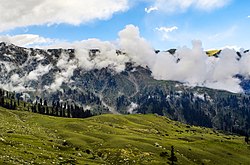
Back سوات Arabic সোয়াত জেলা Bengali/Bangla Districte de Swat Catalan Swāt District CEB Svát Czech Swat Welsh Swat (Pakistan) Danish Swat (Distrikt) German Kantono Sŭat Esperanto Distrito de Swat Spanish
Swat District
ضلع سوات سوات ولسوالۍ | |
|---|---|
| Nickname: Switzerland of Pakistan[1] | |
 Swat District (red) in Khyber Pakhtunkhwa | |
| Coordinates: 35°12′N 72°29′E / 35.200°N 72.483°E | |
| Country | |
| Province | |
| Division | Malakand |
| Capital | Saidu Sharif |
| Largest city | Mingora |
| Number of Tehsils | 7 |
| Government | |
| • Type | District Administration |
| • Deputy Commissioner | N/A |
| • District Police Officer | N/A |
| • District Health Officer | N/A |
| Area | |
| • Total | 5,337 km2 (2,061 sq mi) |
| Population | |
| • Total | 2,687,384 |
| • Density | 500/km2 (1,300/sq mi) |
| • Urban | 794,368 (29.56%) |
| • Rural | 1,893,016 |
| Time zone | UTC+5 (PKT) |
| Area code | Area code 0946 |
| Languages (2017)[3] |
|
| Website | swat |
Swat District (Urdu: ضلع سوات, Pashto: سوات ولسوالۍ, pronounced [ˈswaːt̪]), also known as the Swat Valley, is a district in the Malakand Division of Khyber Pakhtunkhwa, Pakistan. Known for its stunning natural beauty, the district is a popular tourist destination. With a population of 2,687,384 per the 2023 national census, Swat is the 15th-largest district of Khyber Pakhtunkhwa.
Swat District is centred on the Valley of Swat, usually referred to simply as Swat, which is a natural geographic region surrounding the Swat River. The valley was a major centre of early Buddhism of the ancient civilisation of Gandhara, mainly Gandharan Buddhism, with pockets of Buddhism persisting in the valley until the 16th century conquest of Swat by the Yousafzais, after which the area became largely Muslim, along with the Pashtunization of Swat and its neighbouring regions.[4][5][6][7] In the early 19th century, Swat emerged as an independent state under Saidu Baba. State of Swat became a Princely state under British suzerainty as part of the British Raj in 1918.
In 1947, following the Partition of British India and subsequent independence of Pakistan, Swat acceded to the Dominion of Pakistan continuing as a self-governing princely state until it was officially annexed and merged into West Pakistan and later became a part of North-West Frontier Province (now Khyber Pakhtunkhwa) in 1969. The region was seized by the Tehrik-i-Taliban in late-2007 until Pakistani control was re-established in mid-2009.[8][9]
The average elevation of Swat is 980 m (3,220 ft),[5] resulting in a considerably cooler and wetter climate compared to the rest of Pakistan. With lush forests, verdant alpine meadows, and snow-capped mountains, Swat is one of the country's most popular tourist destinations.[10][11]
- ^ Malala Yousafzai 2013.
- ^ Cite error: The named reference
2023 censuswas invoked but never defined (see the help page). - ^ Stephen P. Cohen (2004). The Idea of Pakistan. Brookings Institution Press. p. 202. ISBN 0815797613.
- ^ East and West, Volume 33. Istituto italiano per il Medio ed Estremo Oriente. 1983. p. 27.
According to the 13th century Tibetan Buddhist Orgyan pa forms of magic and Tantra Buddhism and Hindu cults still survived in the Swāt area even though Islam had begun to uproot them (G. Tucci, 1971, p. 375) ... The Torwali of upper Swāt would have been converted to Islam during the course of the 17th century (Biddulph, p. 70).
- ^ a b Mohiuddin, Yasmeen Niaz (2007). Pakistan: A Global Studies Handbook. ABC-CLIO. ISBN 9781851098019.
- ^ Naik, C. D. (2010). Buddhism and Dalits: Social Philosophy and Traditions. Gyan Publishing House. p. 39. ISBN 978-81-7835-792-8. Archived from the original on 15 November 2023. Retrieved 28 May 2023.
Buddhism survived in Gilgit and Baltistan until 13-14th Century, perhaps slightly longer in the nearby Swat Valley.
- ^ Arlinghaus, Joseph Theodore (1988). The Transformation of Afghan Tribal Society: Tribal Expansion, Mughal Imperialism and the Roshaniyya Insurrection, 1450-1600. Duke University. p. 191.
- ^ Abbas, Hassan (24 June 2014). The Taliban Revival: Violence and Extremism on the Pakistan-Afghanistan Frontier. Yale University Press. ISBN 9780300178845.
- ^ Craig, Tim (9 May 2015). "The Taliban once ruled Pakistan's Swat Valley. Now peace has returned". Washington Post. ISSN 0190-8286. Archived from the original on 24 January 2022. Retrieved 11 February 2018.
- ^ Khaliq, Fazal (17 January 2018). "Tourists throng Swat to explore its natural beauty". DAWN.COM. Archived from the original on 11 February 2018. Retrieved 10 February 2018.
- ^ "The revival of tourism in Pakistan". Daily Times. 9 February 2018. Archived from the original on 13 February 2018. Retrieved 12 February 2018.


